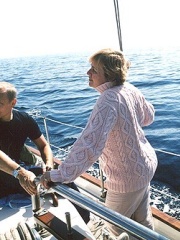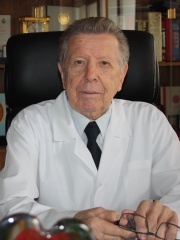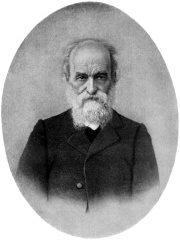
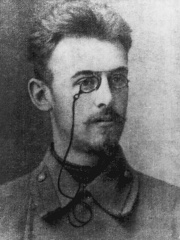
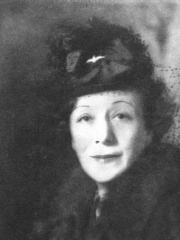
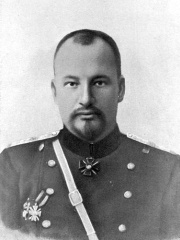
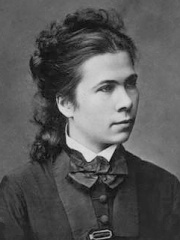
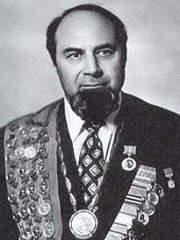
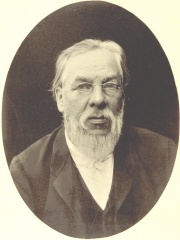
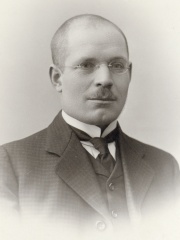
The Most Famous
PHYSICIANS from Russia
This page contains a list of the greatest Russian Physicians. The pantheon dataset contains 726 Physicians, 14 of which were born in Russia. This makes Russia the birth place of the 12th most number of Physicians behind Spain, and Japan.
Top 10
The following people are considered by Pantheon to be the top 10 most legendary Russian Physicians of all time. This list of famous Russian Physicians is sorted by HPI (Historical Popularity Index), a metric that aggregates information on a biography's online popularity. Visit the rankings page to view the entire list of Russian Physicians.

1. Leonid Rogozov (1934 - 2000)
With an HPI of 66.29, Leonid Rogozov is the most famous Russian Physician. His biography has been translated into 26 different languages on wikipedia.
Leonid Ivanovich Rogozov (Russian: Леони́д Ива́нович Ро́гозов; 14 March 1934 – 21 September 2000) was a Russian general practitioner and surgeon who took part in the Sixth Soviet Antarctic Expedition at Novolazarevskaya Station from September 1960 to October 1962. He is best known for performing a surgery to remove his own appendix—an auto-appendectomy—after he began suffering from appendicitis while deployed there in April 1961. The incident, which occurred because Rogozov was the only medical professional among his entire team, prompted the Soviet government to reform the safety policies for all personnel at the country's Antarctic research facilities.

2. Nikolai Korotkov (1874 - 1920)
With an HPI of 61.97, Nikolai Korotkov is the 2nd most famous Russian Physician. His biography has been translated into 18 different languages.
Nikolai Sergeyevich Korotkov, also Korotkoff (Russian: Никола́й Серге́евич Коротко́в; 26 February [O.S. 14 February] 1874 – 14 March 1920) was a Russian surgeon, a pioneer of 20th-century vascular surgery, and the inventor of auscultatory technique for blood pressure measurement.

3. Vera Weizmann (1881 - 1966)
With an HPI of 61.32, Vera Weizmann is the 3rd most famous Russian Physician. Her biography has been translated into 19 different languages.
Vera Weizmann (née Chatzman) (Hebrew: ורה ויצמן; 27 November 1881 – 24 September 1966), wife of Chaim Weizmann, the first president of the State of Israel, was a medical doctor and a Zionist activist.

4. Eugene Botkin (1865 - 1918)
With an HPI of 61.29, Eugene Botkin is the 4th most famous Russian Physician. His biography has been translated into 19 different languages.
Yevgeny Sergeyevich Botkin (Russian: Евгений Сергеевич Боткин; 27 March 1865 – 17 July 1918), commonly known as Eugene Botkin, was the court physician since 1908 for Tsar Nicholas II and Tsarina Alexandra. He sometimes treated the Tsarevich Alexei Nikolaevich of Russia for haemophilia-related complications, like in Spala in 1912. Following the Russian Revolution of 1917, Botkin went into exile with the Romanov family, accompanying them to Tobolsk and Yekaterinburg in Siberia. He was murdered with the Imperial family by guards on 17 July 1918. Like the Romanov family, Botkin was canonised in 1981 as a New Martyr by the Russian Orthodox Church Outside of Russia. In 2000, the Russian Orthodox Church canonised the Romanov family as passion bearers. On 3 February 2016, the Bishop's Council of the Russian Orthodox Church canonised Botkin as Righteous Passion-Bearer Yevgeny the Physician.
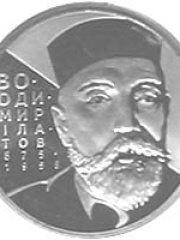
5. Vladimir Filatov (1875 - 1956)
With an HPI of 58.03, Vladimir Filatov is the 5th most famous Russian Physician. His biography has been translated into 17 different languages.
Vladimir Petrovich Filatov (Russian: Владимир Петрович Филaтoв, 27 February [O.S. 15 February] 1875 – 30 October 1956) was a Russian Empire and Soviet ophthalmologist and surgeon best known for his development of tissue therapy. He introduced the tube flap grafting method, corneal transplantation and preservation of grafts from cadaver eyes. He founded the Institute of Eye Diseases & Tissue Therapy in Odessa, Soviet Union (today Ukraine). Filatov is also credited for restoring Vasily Zaytsev's sight when he suffered an injury to his eyes from a mortar attack during Battle of Stalingrad. The first corneal transplantation was attempted by Filatov on 28 February 1912, but the graft grew opaque. After numerous attempts over the course of many years, Filatov achieved a successful transplantation of cornea from a diseased person on 6 May 1931. Throughout his life, Filatov made no secret of the fact that he was a devout Orthodox Christian. The Communist Party honoured him for his medical work, but pretended not to notice his faith. A large group of official representatives from the Kremlin came for his funeral, which was to be a majestic affair, ending with the bier being burned. His widow asked that his will be read out in front of everyone. He asked for an Orthodox funeral conducted by a bishop, and he wanted to be buried, with the tomb stone proclaiming "I look for the resurrection of the dead." The Kremlin gave permission for his wishes to be fulfilled. After Filatov's death in 1956, his apprentice Nadezhda Puchkovskaya led the Institute of Eye Diseases & Tissue Therapy in Odessa, which was renamed in honour of Filatov as The Filatov Institute of Eye Diseases & Tissue Therapy.

6. Nadezhda Suslova (1843 - 1918)
With an HPI of 57.64, Nadezhda Suslova is the 6th most famous Russian Physician. Her biography has been translated into 23 different languages.
Nadezhda Prokofyevna Suslova (Russian: Надежда Прокофьевна Суслова; 1 September 1843 – 20 April 1918) was Russia's first woman medical doctor and the sister of Polina Suslova. She worked as a gynecologist in Nizhny Novgorod, and was involved in many charity efforts.

7. Arkady Vorobyov (1924 - 2012)
With an HPI of 57.30, Arkady Vorobyov is the 7th most famous Russian Physician. His biography has been translated into 20 different languages.
Arkady Nikitich Vorobyov (Russian: Аркадий Никитич Воробьёв; 3 October 1924 – 22 December 2012) was a Soviet and Russian weightlifter, weightlifting coach, scientist and writer. He competed at the 1952, 1956 and 1960 Olympics and won one bronze and two gold medals. Between 1950 and 1960 he set 16 official world records. Later for many years he led the national team and the Soviet weightlifting program. In 1995 he was inducted into the International Weightlifting Federation Hall of Fame.

8. Sergey Botkin (1832 - 1889)
With an HPI of 57.26, Sergey Botkin is the 8th most famous Russian Physician. His biography has been translated into 21 different languages.
Sergey Petrovich Botkin (Russian: Серге́й Петро́вич Бо́ткин; 5 September 1832 – 12 December 1889) was a Russian clinician, therapist, and activist, one of the founders of modern Russian medical science and education. He introduced triage, pathological anatomy, and post mortem diagnostics into Russian medical practice.

9. Nikolay Burdenko (1876 - 1946)
With an HPI of 56.33, Nikolay Burdenko is the 9th most famous Russian Physician. Her biography has been translated into 19 different languages.
Nikolay Nilovich Burdenko (Russian: Николай Нилович Бурденко; 22 May [O.S. 3 June] 1876 – 11 November 1946) was a Russian and Soviet surgeon, the founder of Russian neurosurgery. He was Surgeon-General of the Red Army (1937–1946), an academician of the USSR Academy of Sciences (from 1939), an academician and the first director of the Academy of Medical Sciences of the USSR (1944–1946), a Hero of Socialist Labor (from 1943), Colonel General of medical services, and a Stalin Prize winner (1941). He was a veteran of the Russo-Japanese War, First World War, Winter War and the German-Soviet War.
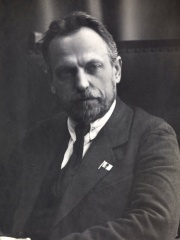
10. Nikolai Semashko (1874 - 1949)
With an HPI of 56.25, Nikolai Semashko is the 10th most famous Russian Physician. His biography has been translated into 16 different languages.
Nikolai Aleksandrovich Semashko (Russian: Никола́й Алекса́ндрович Сема́шко; 26 September [O.S. 14 September] 1874 – 18 May 1949) was a Russian revolutionary and Soviet bureaucrat and physician who became People's Commissar of Public Health in 1918, and served in that role until 1930. He was one of the organizers of the health system in the Soviet Union (often called the Semashko system), an academician of the Academy of Medical Sciences (1944) and of the Russian SFSR (1945).
People
Pantheon has 14 people classified as Russian physicians born between 1832 and 1985. Of these 14, 1 (7.14%) of them are still alive today. The most famous living Russian physicians include Maria Vorontsova. The most famous deceased Russian physicians include Leonid Rogozov, Nikolai Korotkov, and Vera Weizmann.
Living Russian Physicians
Go to all RankingsDeceased Russian Physicians
Go to all RankingsLeonid Rogozov
1934 - 2000
HPI: 66.29
Nikolai Korotkov
1874 - 1920
HPI: 61.97
Vera Weizmann
1881 - 1966
HPI: 61.32
Eugene Botkin
1865 - 1918
HPI: 61.29
Vladimir Filatov
1875 - 1956
HPI: 58.03
Nadezhda Suslova
1843 - 1918
HPI: 57.64
Arkady Vorobyov
1924 - 2012
HPI: 57.30
Sergey Botkin
1832 - 1889
HPI: 57.26
Nikolay Burdenko
1876 - 1946
HPI: 56.33
Nikolai Semashko
1874 - 1949
HPI: 56.25
Yevgeniy Chazov
1929 - 2021
HPI: 54.49
Peter Lesgaft
1837 - 1909
HPI: 52.95
Overlapping Lives
Which Physicians were alive at the same time? This visualization shows the lifespans of the 11 most globally memorable Physicians since 1700.

